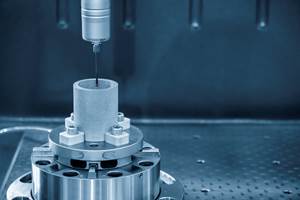Surpassing The Speed Limit In CGI
Advancing rotary-insert machining may have implications for other difficult materials as well.
Share





Early machining tests in compacted graphite iron (CGI) suggested that the tool technology available today would not permit a particularly high cutting speed. Much faster cutting is possible in gray iron because of the presence of sulfur. The sulfur in the metal contributes to a layer of MnS (manganese sulfide) that lubricates the tool during machining. But in CGI, there is no sulfur and therefore no capacity for MnS. Without this lubrication, the cutter in CGI today can’t hope to cut much faster than 500 sfm.
Or so it was thought. Faster cutting is indeed possible, it turns out, if the cutting action of the tool is changed.
In the last couple of years, researchers at Cincinnati Lamb (Chesterfield, Michigan) have seen dramatic improvements in milling efficiency by machining CGI with rotary-insert tooling. In a rotary-insert tool, each cutting insert rides on a bearing that leaves the insert free to spin. Using this tool design, the company has achieved speeds surpassing 3,000 sfm in CGI, using the same ceramic insert material limited to slower speeds in more conventional bodies. The proportionate improvement in tool life is just as large.
Cincinnati Lamb engineering manager George Georgiou points out that the way this tooling works departs from the way metal has been machined since the 1800s. For a standard milling tool, machining consists of overpowering the workpiece material to shear away a chip, with energy losses converted into heat. The rotary-insert tool adds the rotation of the insert to this process, so that some of the energy is spent on driving the rotation instead. Reducing the amount of heat in the cut serves to protect the tool and improve its performance.
The tool design itself is not a new technology. Rotary-insert tooling has long been available, finding a use in certain cases to extend tool life in the machining of gray iron. For the most part, however, this tool design has been a solution in search of a problem. The cost of a tool body equipped with precision bearings generally can’t justify the amount of process improvement the tool can deliver. The degree of improvement seen in CGI is an exception.
More Power
The attention that Cincinnati Lamb and other metalworking suppliers are giving to CGI directly relates to an expected increase in diesel engine production, says Mr. Georgiou. Various automakers have plans to re-introduce diesel engines to the U.S. passenger car market because of the fuel economy this engine design can deliver. CGI makes the fuel economy even better still. Compared to gray iron, an engine made from CGI can deliver the same amount of power in a smaller package.
The material’s strength makes this possible, but that same characteristic makes the material difficult to machine. Because of the high forces required, Cincinnati Lamb’s successes with cutting CGI have relied not just on the rotary-insert tooling, but also on high-power, high-rigidity machine tools.
The company’s objective today is to improve the design of the rotary-insert tooling. This is seen as the principal technical challenge to achieving a more practical CGI milling process. The bearing cartridge introduces a brand new wear component to the tool, and engineers testing new designs for this cartridge aim to achieve longer and more consistent life. At the same time, engineers are working to decrease the tool’s minimum size. Current rotary-insert tooling permits machining of bores down to 3 inches in diameter. Cincinnati Lamb hopes to reduce that limit at least to 2 inches.
One hope for all of this improvement to the rotary-insert tool is that it will lead to payoff not just in the automotive industry, but in farther removed applications as well. Says Mr. Georgiou, “There is no theoretical reason why this same concept could not be applied to titanium, Inconel, Waspalloy, metal matrix composite and just about any other material that has historically been difficult to machine.”
Related Content
Briquetting Manufacturer Tools Up for Faster Turnaround Times
To cut out laborious manual processes like hand-grinding, this briquette manufacturer revamped its machining and cutting tool arsenal for faster production.
Read MoreShop Reclaims 10,000 Square Feet with Inventory Management System
Intech Athens’ inventory management system, which includes vertical lift modules from Kardex Remstar and tool management software from ZOLLER, has saved the company time, space and money.
Read MoreOrthopedic Event Discusses Manufacturing Strategies
At the seminar, representatives from multiple companies discussed strategies for making orthopedic devices accurately and efficiently.
Read MoreParts and Programs: Setup for Success
Tips for program and work setups that can simplify adjustments and troubleshooting.
Read MoreRead Next
AMRs Are Moving Into Manufacturing: 4 Considerations for Implementation
AMRs can provide a flexible, easy-to-use automation platform so long as manufacturers choose a suitable task and prepare their facilities.
Read MoreMachine Shop MBA
Making Chips and 91ĘÓƵÍřŐľÎŰ are teaming up for a new podcast series called Machine Shop MBA—designed to help manufacturers measure their success against the industry’s best. Through the lens of the Top Shops benchmarking program, the series explores the KPIs that set high-performing shops apart, from machine utilization and first-pass yield to employee engagement and revenue per employee.
Read More





















